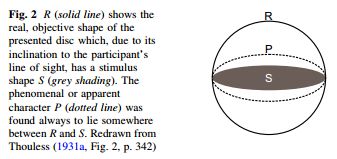A participant views a circle placed on a table in front of them, and is asked to describe what they see. Their answer lies somewhere between what geometry tells us the retinal image should be (or, what we might render in a virtual world), and the “real” version of the circle, undistorted by perspective. Back in the ’30s, Thouless observed this, and dubbed it “phenomenal regression” — that the observed, “phenomenal” shape is not the expected retinal image, but rather “regresses” to the “real” shape.
This makes some sense with shapes (and orientations) simple enough to describe perspective transformation as compression on one axis; that is to say, when the “real” form is unambiguously just a circle, because other orientations are significantly less interesting. Or perhaps the real shape is that aligned with the plane the object rests on — a mental estimation of an overhead view of the table?
Thouless claims it’s not simply a familiar form, though that experiment bears another read to convince me. There’s also a bit on properties like brightness/color; Thouless seems to imply shape is not the only property for which we exhibit this regression, and that seems to further confuse how one constructs the “real” form.
Elner and Wright have recently (2014) explored using the concept as a measure of “spatial quality” in virtual environments; they introduce regression as “an involuntary reaction that cannot be defeated even when pointed out”, which could make for a compelling measure. Their experiment is inconclusive (virtual cues possibly influenced by a physical tripod), and I’ll need to become more familiar with the lit on size constancy to understand why they claim so strongly that it’s not what they (nor Thouless) are doing. But, they’ve a thorough paper, particularly related works and analysis; I suspect they do know what they’re doing, and I should probably revisit this sometime to better understand the implications.
-
Elner, K. W., & Wright, H. (2014). Phenomenal regression to the real object in physical and virtual worlds. Virtual Reality, 1-11.
-
Thouless, R. H. (1931). Phenomenal regression to the real object. I. British Journal of Psychology. General Section, 21(4), 339-359.
-
Thouless, Robert H. “Phenomenal regression to the ‘real’object. II.” British Journal of Psychology. General Section 22.1 (1931): 1-30.

